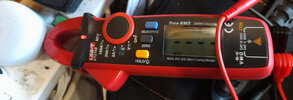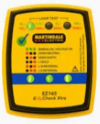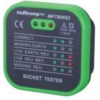Hi, Plugged toaster in yesterday and after a brief period there was a flash and bang from socket. I had the Microwave running for a good few minutes prior to the with no issues. Tested the socket with a Socket Checker and got all clear. Kettle boiled ok. So I am presuming issue with toaster. Any pointers on how I can check the toaster please ! Could I use an RCD Adaptor for lawnmower to check ?
You are using an out of date browser. It may not display this or other websites correctly.
You should upgrade or use an alternative browser.
You should upgrade or use an alternative browser.
Flash/Bang
- Thread starter JMC51
- Start date
Sponsored Links
Have you tried the toaster again subsequent to that experience?Hi, Plugged toaster in yesterday and after a brief period there was a flash and bang from socket. I had the Microwave running for a good few minutes prior to the with no issues. Tested the socket with a Socket Checker and got all clear. Kettle boiled ok. So I am presuming issue with toaster. Any pointers on how I can check the toaster please ! Could I use an RCD Adaptor for lawnmower to check ?
Kind Regards, John
That's understandable. Sockets obviously should not 'flash and bang', so there's presumably something 'not right' about it, so one approach would be to simply replace the socket.Hi John, Put it on briefly shortly after and no issues but I am twitchy about putting it on in case it causes any problems.
My knowledge of electrics is not great and I tend not to play with it other than swapping like for like.
Jim
Kin Regards, John
Sponsored Links
Presumably no RCD protection on the circuit (pic of your CU and surrounding switchgear if you're not sure what you're looking at or for).
And if you have an rcd lawnmower adaptor yes try it.
Your problem MAY have been excess crumbs in the toaster, built up til they've caused a short L-N or L- E. That short would pull a lot of current (thus the flash/bang in the socket) til the carbon buildup in the toaster burned off.
And if you have an rcd lawnmower adaptor yes try it.
Your problem MAY have been excess crumbs in the toaster, built up til they've caused a short L-N or L- E. That short would pull a lot of current (thus the flash/bang in the socket) til the carbon buildup in the toaster burned off.
Thanks everybody I used the microwave in socket yesterday with no issues but will check/replace socket and will probably replace toaster as it is a good age.
I have a multimeter but not proficient with it. Set it to 200ohms multimeter reads1 at this point, when I connected tips read 0 when I put left button on toaster I get a reading of around 70 , the right button shows no movement sitting at 1. When the socket tripped I was using both sides but I tried later with only left side and no issues.
I have a multimeter but not proficient with it. Set it to 200ohms multimeter reads1 at this point, when I connected tips read 0 when I put left button on toaster I get a reading of around 70 , the right button shows no movement sitting at 1. When the socket tripped I was using both sides but I tried later with only left side and no issues.
- Joined
- 27 Jan 2008
- Messages
- 23,865
- Reaction score
- 2,700
- Location
- Llanfair Caereinion, Nr Welshpool
- Country

Multi-meters have their use, I love mine
 but can't see how it would help you with what has happened. The socket testers come in many flavours like multi-meters, one like this
but can't see how it would help you with what has happened. The socket testers come in many flavours like multi-meters, one like this  with a loop test may show a fault, but one like this
with a loop test may show a fault, but one like this  will not really help, good in caravans to show if supply line - neutral swapped, but very little else.
will not really help, good in caravans to show if supply line - neutral swapped, but very little else.
I had my RCBO (RCD and MCB combined) trip when my roof leaked, and I looked at the socket where the leak was and found the plastic warped due to heat which had been generated inside due to water, but tests showed nothing wrong, I of course changed it, and I would suggest you do the same, it may be an intermittent fault on the switch, or water ingress, or weak spring contact on the plug pins, but you may not find any fault, so safest option would be to change anyway, sockets are not expensive.
As to RCD plugs and sockets, I can see how a 10 mA type may help, but in the main if there is a RCD in the consumer unit, then no point using RCD plugs and sockets.
 but can't see how it would help you with what has happened. The socket testers come in many flavours like multi-meters, one like this
but can't see how it would help you with what has happened. The socket testers come in many flavours like multi-meters, one like this  with a loop test may show a fault, but one like this
with a loop test may show a fault, but one like this  will not really help, good in caravans to show if supply line - neutral swapped, but very little else.
will not really help, good in caravans to show if supply line - neutral swapped, but very little else.I had my RCBO (RCD and MCB combined) trip when my roof leaked, and I looked at the socket where the leak was and found the plastic warped due to heat which had been generated inside due to water, but tests showed nothing wrong, I of course changed it, and I would suggest you do the same, it may be an intermittent fault on the switch, or water ingress, or weak spring contact on the plug pins, but you may not find any fault, so safest option would be to change anyway, sockets are not expensive.
As to RCD plugs and sockets, I can see how a 10 mA type may help, but in the main if there is a RCD in the consumer unit, then no point using RCD plugs and sockets.
While you wrote "there was a flash and bang from socket",Hi, Plugged toaster in yesterday and after a brief period there was a flash and bang from socket. I had the Microwave running for a good few minutes prior to the with no issues. Tested the socket with a Socket Checker and got all clear. Kettle boiled ok. So I am presuming issue with toaster. Any pointers on how I can check the toaster please ! Could I use an RCD Adaptor for lawnmower to check ?
was it from the "socket" or
from the "plug" inserted into it?
That "Toaster Plug" contains a fuse.
Did the fuse "blow" or is the Plug, Fuse and Toaster still operative?
Youre post (#7) concerning multimeter readings on the toaster is not clear.
The Line to Neutral Pin connections on the Plug of a working toaster should indicate a certain resistance.
For a 240 V supply: -
If the toaster is rated at 2000 W, this resistance should be about 29 Ohms.
If the toaster is rated at 1500 W, this resistance should be about 39 Ohms.
If the toaster is rated at 1000 W, this resistance should be about 58 Ohms.
etc.
(Lower than 29 Ohms could indicate significant rubbish/detritus/crumbs, causing a partial short-circuit !)
There should be infinite (or very high) resistance between the Line (and Neutral) to the Earth connection of the "Pins" of the plug
(Any low resistance on the Line to Earth path "Pins" indicates rubbish/detritus/crumbs, causing a partial short-circuit to Earth - which means that you should clean the interior of the toaster - when it is unplugged.)
Last edited:
I am uncertain where the flash came from, toaster was plugged in and working - switched off right away,
Went back later on and tried the right hand side (4 Slicer ) and it started to heat up. Did not try right hand side.
Fuse is intact, And Circuit Beaker at main box did not trip.
Watched a video from espares on checking item my multimeter reads 1 when not connected and 0000 when pins crossed.
Made the switch to left side of toaster and with M/Meter set to 200ohms connected pins to plug this gave me a reading 75.
When I carried out the same process on the right side the meter read 1.
Under the impression that 1 is same as ol.
Tried l/n to earth the same way and got a 1 reading but not sure if done right.
Multimeter is and old Mastech MS8233a. and Socket Tester a Kewtech 103. Toaster 1800w
Bought new socket which I will fit
Thanks to those of have replied and my apologies for my ignorance. As stated earlier I normally stay clear of electrics !
Went back later on and tried the right hand side (4 Slicer ) and it started to heat up. Did not try right hand side.
Fuse is intact, And Circuit Beaker at main box did not trip.
Watched a video from espares on checking item my multimeter reads 1 when not connected and 0000 when pins crossed.
Made the switch to left side of toaster and with M/Meter set to 200ohms connected pins to plug this gave me a reading 75.
When I carried out the same process on the right side the meter read 1.
Under the impression that 1 is same as ol.
Tried l/n to earth the same way and got a 1 reading but not sure if done right.
Multimeter is and old Mastech MS8233a. and Socket Tester a Kewtech 103. Toaster 1800w
Bought new socket which I will fit
Thanks to those of have replied and my apologies for my ignorance. As stated earlier I normally stay clear of electrics !
Last edited:
You wrote "Made the switch to left side of toaster and with M/Meter set to 200ohms connected pins to plug this gave me a reading 75."I am uncertain where the flash came from, toaster was plugged in and working - switched off right away,
Went back later on and tried the right hand side (4 Slicer ) and it started to heat up. Did not try right hand side.
Fuse is intact, And Circuit Beaker at main box did not trip.
Watched a video from espares on checking item my multimeter reads 1 when not connected and 0000 when pins crossed.
Made the switch to left side of toaster and with M/Meter set to 200ohms connected pins to plug this gave me a reading 75.
When I carried out the same process on the right side the meter read 1.
Under the impression that 1 is same as ol.
Tried l/n to earth the same way and got a 1 reading but not sure if done right.
Multimeter is and old Mastech MS8233a. and Socket Tester a Kewtech 103. Toaster 1800w
Bought new socket which I will fit
and
"Toaster 1800 W"
You also spoke about a "4 Slice" toaster, which appears to have two "sections" - for two slices in each side.
A resistance reading of an 1800 W toaster should be about 32 Ohms BUT
for "half" of that Toaster (900 W), 75 Ohms is a bit high but not "unreasonable" - (although it should be about 65 Ohms.)
As I wrote previously
"Any low resistance on the Line to Earth path "Pins" indicates rubbish/detritus/crumbs, causing a partial short-circuit to Earth - which means that you should clean the interior of the toaster - when it is unplugged."
"Socket Testers" are relatively useless devices and 230-240 V sockets and associated equipment are best tested with a Low Impedance (analog) meter - which (now-a-days) are usually only slightly cheaper than the cheapest available Digital Meter.
High Impedance (digital) meters are most suitable "electronic" equipment - where it is desirable not to "load" a circuit when taking a reading.
Some "High End" Digital meters do have the facility to become "Low Impedance" for just this purpose.
While (so far) this situation does not appear to be your present problem, "cheap" digital meters can produce (quite accurate) readings of very small voltages, which may lead an inexperienced user astray!
You now "know" (somehow) that "Socket checked safe"Problem solved. Socket checked safe and Toaster in bin !
Thanks for replies !
and
"Toaster in bin".
This may be a solution for what was a faulty/uncleaned Toaster problem
but
how do you "know" that
the Toaster was not cleanable/repairable
in this "throwaway" society?
DIYnot Local
Staff member
If you need to find a tradesperson to get your job done, please try our local search below, or if you are doing it yourself you can find suppliers local to you.
Select the supplier or trade you require, enter your location to begin your search.
Please select a service and enter a location to continue...
Are you a trade or supplier? You can create your listing free at DIYnot Local
Sponsored Links
Similar threads
- Replies
- 25
- Views
- 2K
- Replies
- 33
- Views
- 5K

